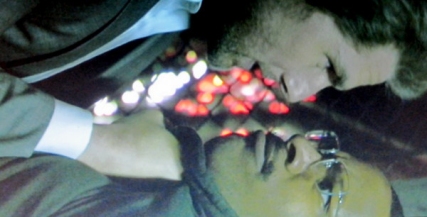by Sam Juliano
The road picture genre is one that’s been so plentifully visited through the years that one would have little disputation giving it an independent classification. Some of the American cinema’s most celebrated characters have traveled across states, trying to evade capture, embarking on various escapades or just geographically fueling their unrest. Joan Graham and Eddie Taylor, Tom Joad, Clyde Barrow, Kit Carruthers, Keechie and Bowie and recently Woody Grant have made their marks on the landscape offering up their blood, sweat and tears, and in some instances their lives to achieve a subversive brand of the American Dream. Of course the Americans don’t remotely hold a monopoly on the stamp, and cinephiles will fondly recall accomplished works such as La Strada, Alice in the Cities, The Vanishing, Wages of Fear, Alice in the Cities and The Trip among others that explore the form with special attention to the sociological, psychological and political elements that fuel the narratives. It is no wonder that a great many of the films that fall into this category are largely about crime, as after all criminals on the run are apt to travel long distances for obvious reasons, but the elements of adventure and transience are the initial or prime proclivity of many road movie protagonists. Of course there are some celebrated road trips made in the recesses of dreams in fantastical locations, with none more famous than the one that featured the yellow brick road and an emerald palace. What unites all road pictures is the insatiable thirst of its characters to leave behind, however temporary, what is invariably seen as a dead end street, and the need to act on some of their hankerings to attain either material or spiritual benefit. The results are a mixed lot.
The acclaimed auteur Peter Bogdonovich followed up on two monster hits in the early 1970s- his magisterial classic The Last Picture Show, and a screwball comedy, What’s Up Doc? The latter was a box-office smash, while the former was greeted by some of the best reviews and American film had received in years, and secured a host of awards and eight Oscar nominations including Best Picture. His third project was actually recommended to him by the studio, but the director initially balked. He later changed his mind largely at the urgings of his former wife Polly Platt, but also because of his fondness of period films and his confidence in the screenwriter Alvin Sargent, who was brought in to adapt Joe David Brown’s novel “Addie Pray.” The renowned cinematographer Laszlo Kovacs was given the assignment, and of course Pratt herself explored locations, for what was to be arresting art direction. The film was to be titled Paper Moon. (more…)























 Click on names for archives
Writers/Founders
Click on names for archives
Writers/Founders